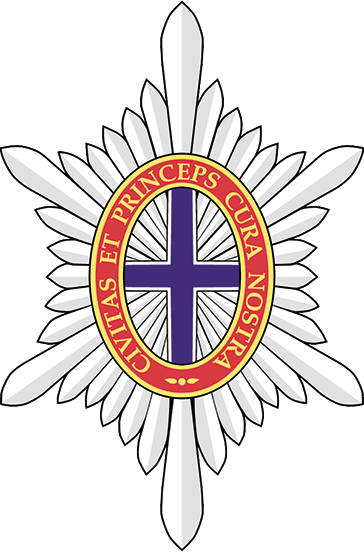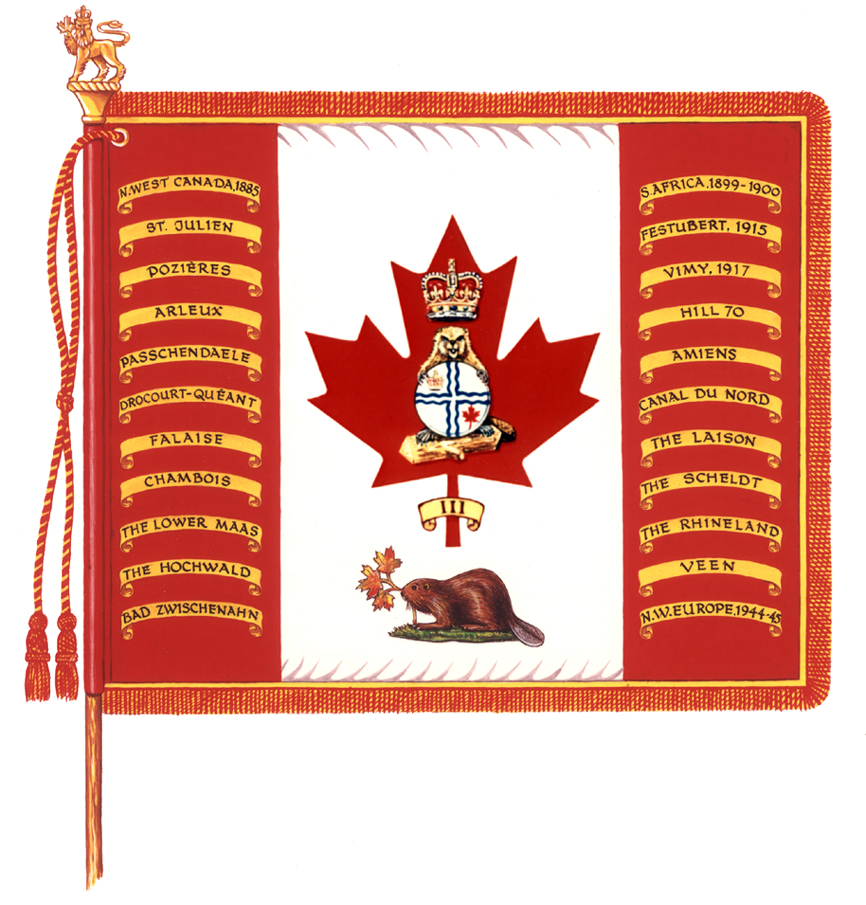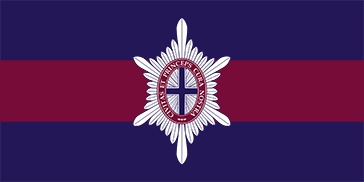Governor General's Foot Guards
The official lineage of the Governor General's Foot Guards infantry regiment.

Badge
Description
Upon a six-pointed star rayonné Argent an annulus Gules edged and inscribed CIVITAS ET PRINCEPS CURA NOSTRA in letters Or and enclosing a cross Azure fimbriated Argent.
Symbolism
The badge is based on the star of the Order of the Garter, which is used a the cap star of the Coldstream Guards, an allied regiment whose uniform, with minor differences, the regiment wears. "CIVITAS ET PRINCEPS CURA NOSTRA" is the motto of the regiment.
Motto
CIVITAS ET PRINCEPS CURA NOSTRA (Our country and ruler are our concern)
Quick March
"Milanollo"
Slow March
"Figaro"
Alliance
British Army
Coldstream Guards
Regimental colour

Note:
Each company of the regiment have their own Company Badge which is borne in rotation in the centre of the Regimental Colour.
Camp flag

Battle honours
North West Rebellion
NORTH WEST CANADA, 1885.
South African War
North West Rebellion
SOUTH AFRICA, 1899-1900.
The First World War
YPRES, 1915, '17; Gravenstafel; St. Julien; FESTUBERT, 1915; MOUNT SORREL; SOMME, 1916; Pozières; Flers-Courcelette; Ancre Heights; ARRAS, 1917, '18; Vimy, 1917; Arleux; Scarpe, 1917, '18; HILL 70; Passchendaele; AMIENS; Drocourt-Quéant; HINDENBURG LINE; Canal du Nord; PURSUIT TO MONS; FRANCE AND FLANDERS, 1915-18.
The Second World War
FALAISE; Falaise Road; The Laison; Chambois; THE SCHELDT; The Lower Maas; THE RHINELAND; The Hochwald; Veen; Bad Zwischenahn; NORTH-WEST EUROPE, 1944-1945.
South-West Asia
AFGHANISTAN
Lineage
This Reserve Force regiment originated in Ottawa, Ontario on 7 June 1872, when the '1st Battalion Governor General's Foot Guards' was authorized to be formed.Footnote 1 It was redesignated: 'Governor General's Foot Guards' on 16 September 1887;Footnote 2 'The Governor General's Foot Guards' on 1 April 1896;Footnote 3 '2nd (Reserve) Battalion, The Governor General's Foot Guards' on 7 November 1941;Footnote 4 'The Governor General's Foot Guards' on 31 January 1946;Footnote 5 'The Governor General's Foot Guards (5th Battalion, The Canadian Guards)' on 1 September 1954;Footnote 6 'Governor General's Foot Guards (5th Battalion, The Canadian Guards)' on 25 April 1958;Footnote 7 and 'Governor General's Foot Guards' on 1 September 1976.Footnote 8
Notes:
On 12 March 1920, the Governor General's Foot Guards were organized as a two battalion regiment with the 1st Battalion (no CEF designation) on the Non Permanent Active Militia order of battle, and the 2nd Battalion (77th Battalion, CEF) on the Reserve order of battle (MO 59/20). The reserve unit was disbanded on 14 December 1936 (GO 3/37).
On 15 December 1931, the 1st Battalion was redesignated the 1st Battalion (2nd Battalion, CEF) (GO 152/31).
The Governor General's Foot Guards were disbanded for the purpose of reorganization on 15 December 1920 and reorganized the same day (GO 30/21). This change was administrative and does not affect the lineage of the regiment.
Perpetuations
'2nd' and '77th "Overseas" Battalion(s), CEF'
Headquarters Location
Ottawa, Ontario
Operational history
North West Rebellion
The 1st Battalion Governor General's Foot Guards mobilized one company for active service on 10 April 1885.Footnote 9 It served in the Battleford Column of the North West Field Force.Footnote 10 The company was removed from active service on 24 July 1885.Footnote 11
South African War
The regiment contributed volunteers for the Canadian Contingents, mainly the '2nd (Special Service) Battalion, Royal Canadian Regiment of Infantry'.Footnote 12
The First World War
Details of the Governor General's Foot Guards were placed on active service on 6 August 1914 for local protection duties.Footnote 13
The 2nd Battalion, which was authorized on 10 August 1914 as the '2nd Battalion, CEF',Footnote 14 embarked for Great Britain on 26 September 1914.Footnote 15 It disembarked in France on 11 February 1915,Footnote 16 where it fought as part of the 1st Infantry Brigade, 1st Canadian Division in France and Flanders until the end of the war.Footnote 17 The battalion was disbanded on 15 September 1920.Footnote 18
The 77th Battalion, which was authorized on 10 July 1915 as the '77th "Overseas" Battalion', CEF,Footnote 19 embarked for Great Britain on 19 June 1916.Footnote 20 It provided reinforcements for the Canadian Corps in the field until 22 September 1916, when its personnel were absorbed by the '47th' and '73rd "Overseas" Battalion, CEF' and the battalion was disbanded.Footnote 21
The Second World War
Details from the regiment were called out on service on 26 August 1939 and then placed on active service on 1 September 1939, under the designation 'The Governor General's Foot Guards, CASF (Details)', for local protection duties.Footnote 22 The details called out on active service were disbanded on 31 December 1940.Footnote 23
The regiment subsequently mobilized 'The Governor General's Foot Guards, CASF' for active service on 24 May 1940.Footnote 24 It was redesignated '1st Battalion, The Governor General's Foot Guards, CASF' on 7 November 1940.Footnote 25 On 26 January 1942, it was converted to armour and redesignated: '21st Armoured Regiment (The Governor General's Foot Guards), CAC, CASF';Footnote 26 and '21st Armoured Regiment (The Governor General's Foot Guards), RCAC, CASF' on 2 August 1945.Footnote 27 It embarked for Great Britain on 23 September 1942.Footnote 28 On 24 July 1944, it landed in France as part of the 4th Armoured Brigade, 4th Canadian Armoured Division, and it continued to fight in North-West Europe until the end of the war.Footnote 29 The overseas regiment was disbanded on 31 January 1946.Footnote 30
South-West Asia
From 2002 to 2014, the GGFG reinforced various CAF units deployed to Afghanistan. Footnote 31
Page details
- Date modified: